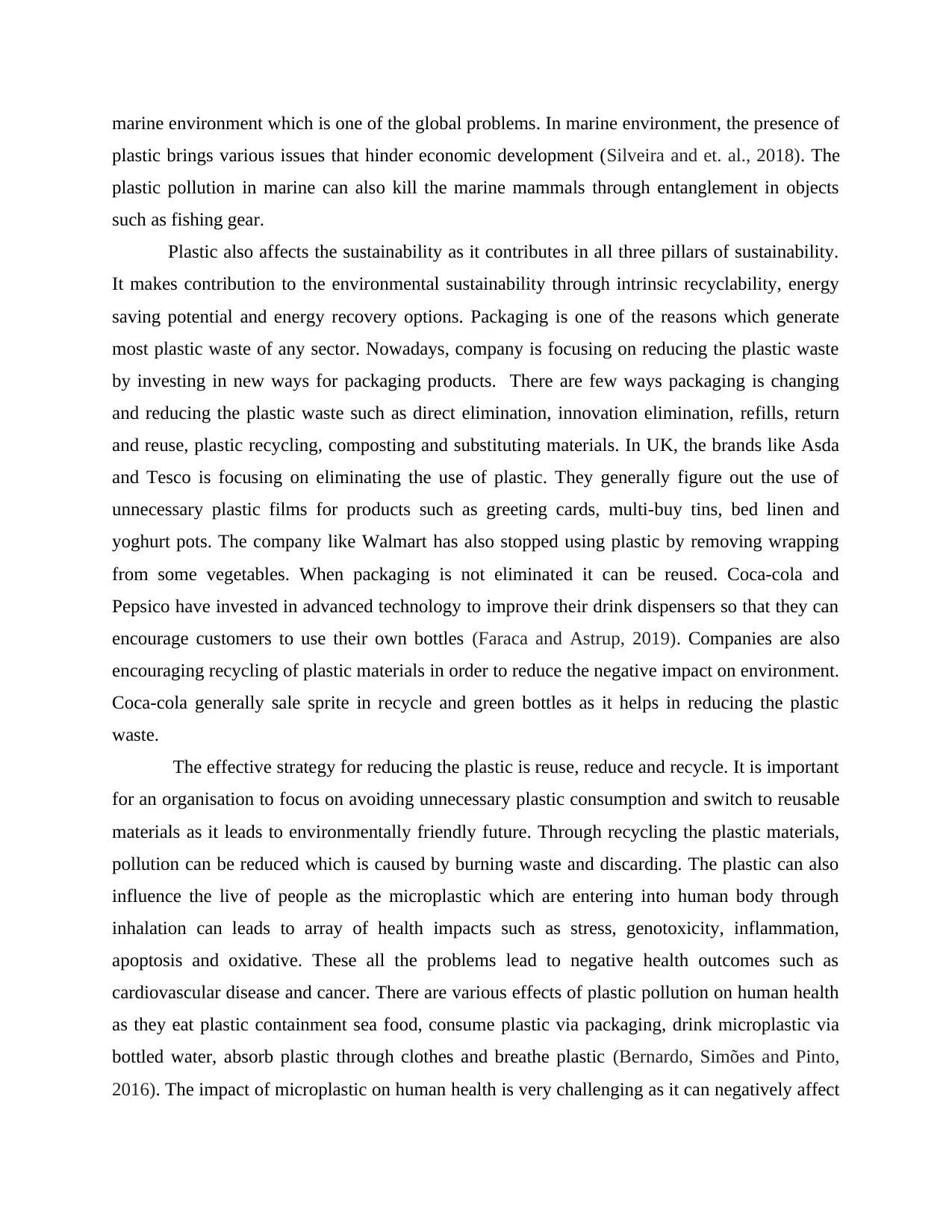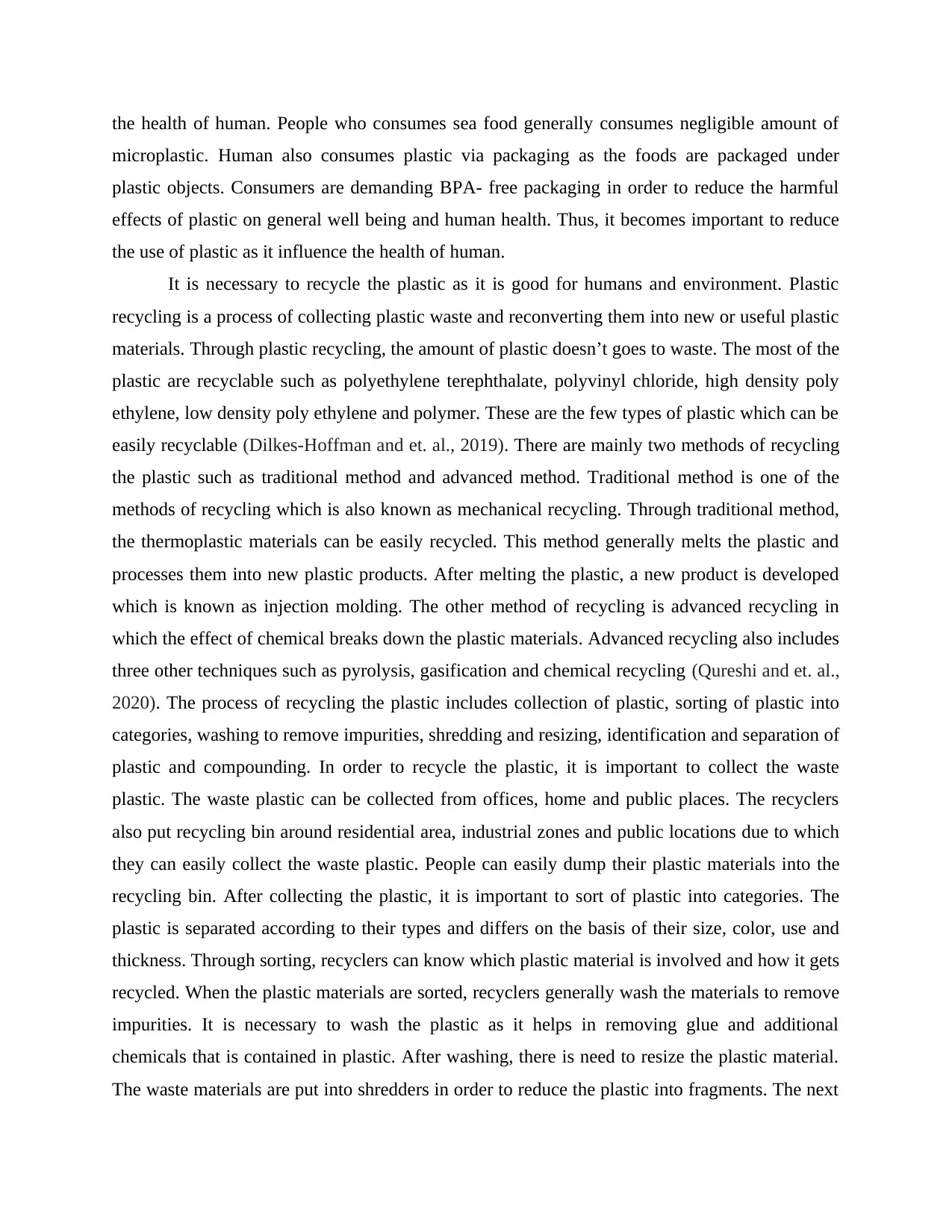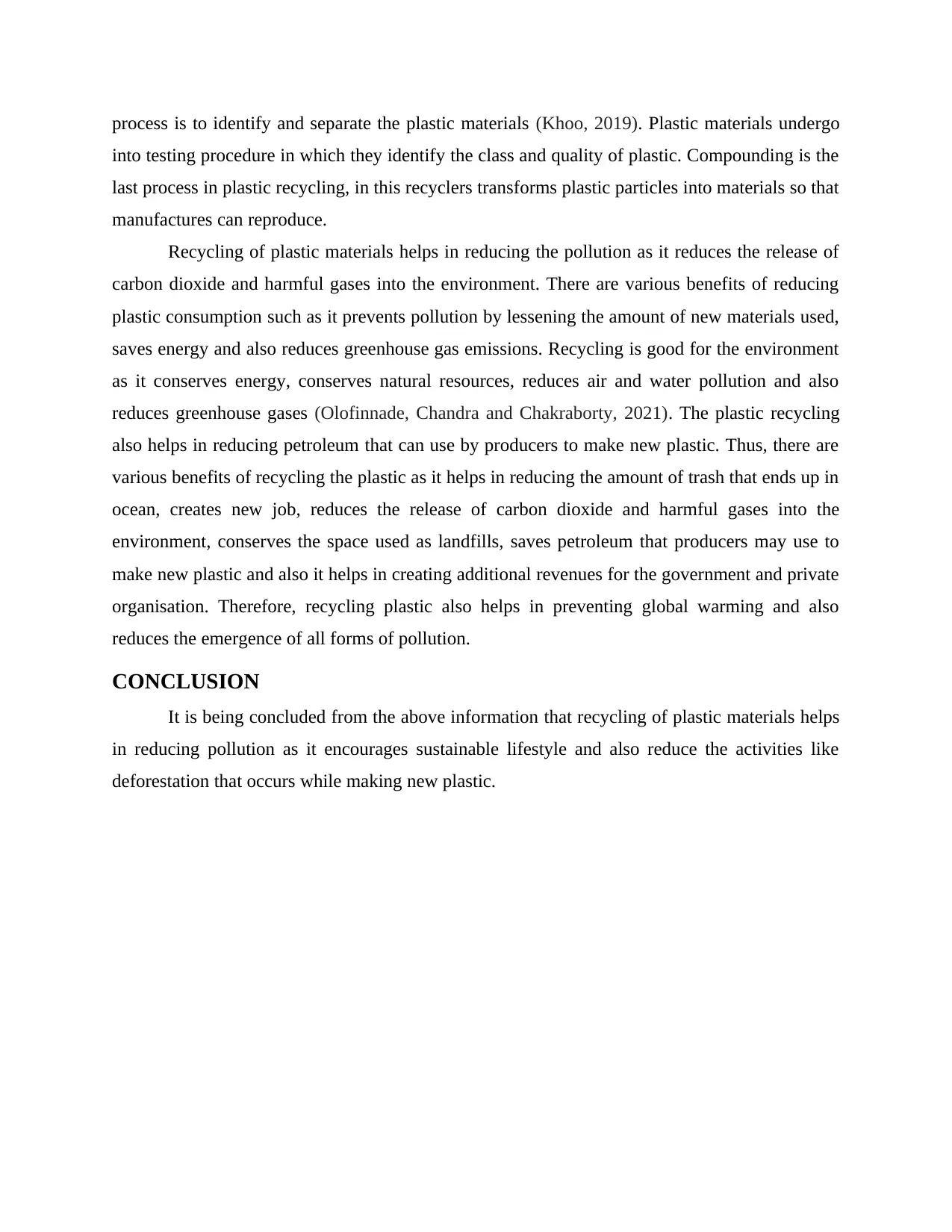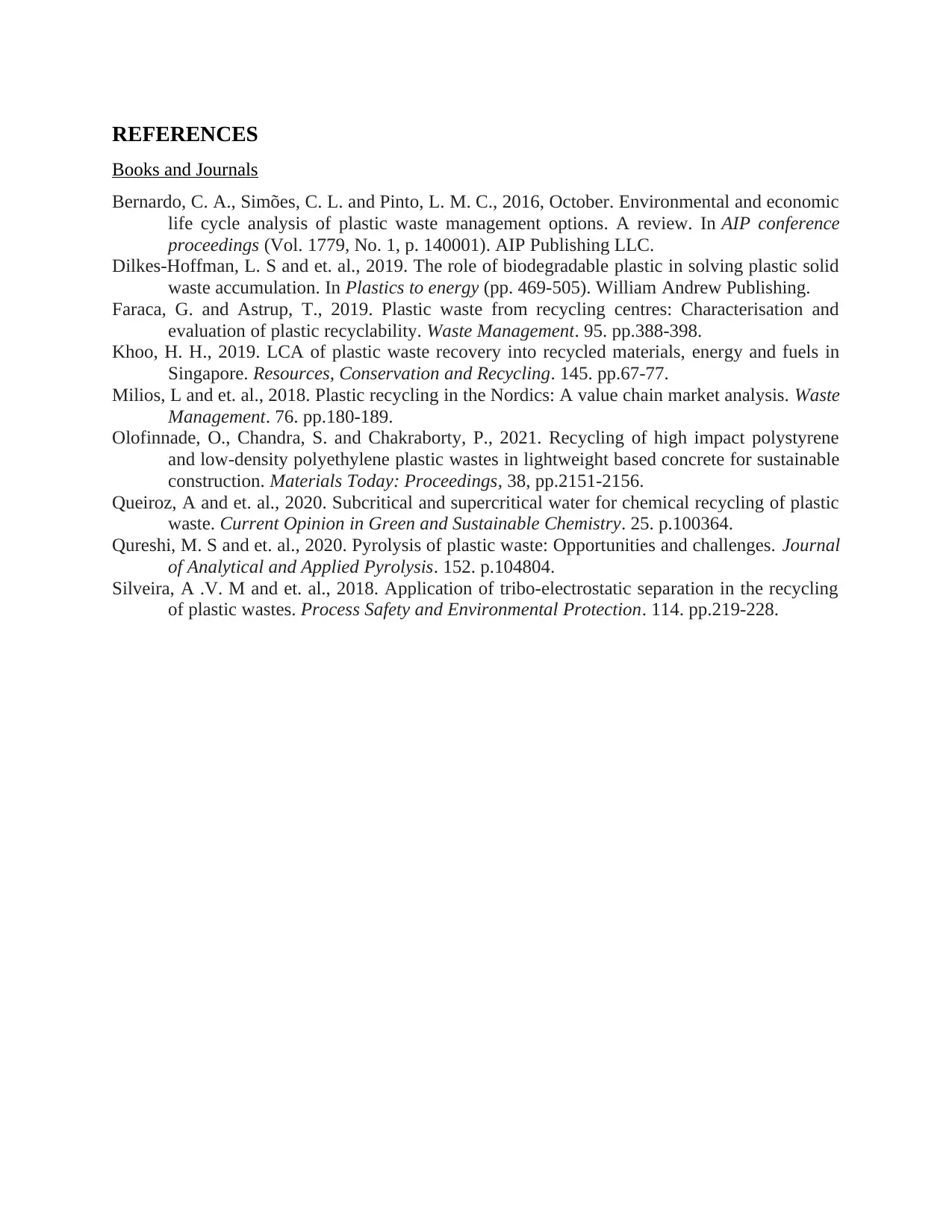Reducing Plastic Materials: Impact on Environment and Sustainability
VerifiedAdded on 2023/06/11
|7
|2078
|115
AI Summary
This essay discusses the impact of plastic materials on the environment and the importance of sustainability. It also provides insights on how to reduce plastic materials and the benefits of recycling them.
Contribute Materials
Your contribution can guide someone’s learning journey. Share your
documents today.

Introduction to Visual Culture
Secure Best Marks with AI Grader
Need help grading? Try our AI Grader for instant feedback on your assignments.

Table of Contents
INTRODUCTION...........................................................................................................................3
ESSAY.............................................................................................................................................3
CONCLUSION................................................................................................................................6
REFERENCES................................................................................................................................7
INTRODUCTION...........................................................................................................................3
ESSAY.............................................................................................................................................3
CONCLUSION................................................................................................................................6
REFERENCES................................................................................................................................7

INTRODUCTION
The essay is based on environment and sustainability, it provides a clarity about how to
reduce the plastic materials and what are its impact on environment. It is necessary to recycle the
plastic materials in order to reduce the pollution of environment. Plastic creates a great impact on
environment as it takes long time to decompose. When the plastic products are perished under
sunlight it released toxic substances which are harmful for the environment and human.
Sustainability is a process of meeting the needs without influencing the natural resources of
environment (Milios and et. al., 2018). Thus, sustainability is important for reducing the plastic
materials as it helps in enhancing liveability and also foster environmental responsibility.
ESSAY
Environment generally defined the number of living and non-living elements and their
influence on human life. There are mainly three types of environment such as natural
environment, human environment and physical environment. There are various causes of
environment such as pollution, global warming, waste disposal, loss of biodiversity, usage of
plastic and various others. Use of plastic materials is one of the negative causes on environment.
People generally use plastic bags to carry their clothes or food items which they brought from
shops. They use plastic bags even though they know the negative effect of plastic on human as
well as animal’s life. The plastic materials become one of the major items in solid waste which
results in negative environment effects including blockage of channels or river, animal choking,
landscape disfigurement and pollution (Queiroz and et. al., 2020). These are the few reasons due
to which people have raised their voice to ban the use of plastic.
The impact of plastic bags on environment is that it takes several years to decompose. It
also releases toxic substances into soil when plastic is perishing under sunlight. If the plastic
materials are burned it releases toxic substances into air causing ambient air pollution. It is being
also analyzed that the use of plastic also leads to cancerous disease. Thus, it is important to
decompose the plastic bags as if they are properly disposed it can create an impact on
environment by causing stormwater drain blockages and littering. Through plastic, animals also
get affected as they generally confuse the bags for food and consume it which blocks their
digestive process. Animals consume the plastic materials which may cause choking, starvation,
infection, mortality, reduced reproductive success and laceration. Plastic are also presented in
The essay is based on environment and sustainability, it provides a clarity about how to
reduce the plastic materials and what are its impact on environment. It is necessary to recycle the
plastic materials in order to reduce the pollution of environment. Plastic creates a great impact on
environment as it takes long time to decompose. When the plastic products are perished under
sunlight it released toxic substances which are harmful for the environment and human.
Sustainability is a process of meeting the needs without influencing the natural resources of
environment (Milios and et. al., 2018). Thus, sustainability is important for reducing the plastic
materials as it helps in enhancing liveability and also foster environmental responsibility.
ESSAY
Environment generally defined the number of living and non-living elements and their
influence on human life. There are mainly three types of environment such as natural
environment, human environment and physical environment. There are various causes of
environment such as pollution, global warming, waste disposal, loss of biodiversity, usage of
plastic and various others. Use of plastic materials is one of the negative causes on environment.
People generally use plastic bags to carry their clothes or food items which they brought from
shops. They use plastic bags even though they know the negative effect of plastic on human as
well as animal’s life. The plastic materials become one of the major items in solid waste which
results in negative environment effects including blockage of channels or river, animal choking,
landscape disfigurement and pollution (Queiroz and et. al., 2020). These are the few reasons due
to which people have raised their voice to ban the use of plastic.
The impact of plastic bags on environment is that it takes several years to decompose. It
also releases toxic substances into soil when plastic is perishing under sunlight. If the plastic
materials are burned it releases toxic substances into air causing ambient air pollution. It is being
also analyzed that the use of plastic also leads to cancerous disease. Thus, it is important to
decompose the plastic bags as if they are properly disposed it can create an impact on
environment by causing stormwater drain blockages and littering. Through plastic, animals also
get affected as they generally confuse the bags for food and consume it which blocks their
digestive process. Animals consume the plastic materials which may cause choking, starvation,
infection, mortality, reduced reproductive success and laceration. Plastic are also presented in

marine environment which is one of the global problems. In marine environment, the presence of
plastic brings various issues that hinder economic development (Silveira and et. al., 2018). The
plastic pollution in marine can also kill the marine mammals through entanglement in objects
such as fishing gear.
Plastic also affects the sustainability as it contributes in all three pillars of sustainability.
It makes contribution to the environmental sustainability through intrinsic recyclability, energy
saving potential and energy recovery options. Packaging is one of the reasons which generate
most plastic waste of any sector. Nowadays, company is focusing on reducing the plastic waste
by investing in new ways for packaging products. There are few ways packaging is changing
and reducing the plastic waste such as direct elimination, innovation elimination, refills, return
and reuse, plastic recycling, composting and substituting materials. In UK, the brands like Asda
and Tesco is focusing on eliminating the use of plastic. They generally figure out the use of
unnecessary plastic films for products such as greeting cards, multi-buy tins, bed linen and
yoghurt pots. The company like Walmart has also stopped using plastic by removing wrapping
from some vegetables. When packaging is not eliminated it can be reused. Coca-cola and
Pepsico have invested in advanced technology to improve their drink dispensers so that they can
encourage customers to use their own bottles (Faraca and Astrup, 2019). Companies are also
encouraging recycling of plastic materials in order to reduce the negative impact on environment.
Coca-cola generally sale sprite in recycle and green bottles as it helps in reducing the plastic
waste.
The effective strategy for reducing the plastic is reuse, reduce and recycle. It is important
for an organisation to focus on avoiding unnecessary plastic consumption and switch to reusable
materials as it leads to environmentally friendly future. Through recycling the plastic materials,
pollution can be reduced which is caused by burning waste and discarding. The plastic can also
influence the live of people as the microplastic which are entering into human body through
inhalation can leads to array of health impacts such as stress, genotoxicity, inflammation,
apoptosis and oxidative. These all the problems lead to negative health outcomes such as
cardiovascular disease and cancer. There are various effects of plastic pollution on human health
as they eat plastic containment sea food, consume plastic via packaging, drink microplastic via
bottled water, absorb plastic through clothes and breathe plastic (Bernardo, Simões and Pinto,
2016). The impact of microplastic on human health is very challenging as it can negatively affect
plastic brings various issues that hinder economic development (Silveira and et. al., 2018). The
plastic pollution in marine can also kill the marine mammals through entanglement in objects
such as fishing gear.
Plastic also affects the sustainability as it contributes in all three pillars of sustainability.
It makes contribution to the environmental sustainability through intrinsic recyclability, energy
saving potential and energy recovery options. Packaging is one of the reasons which generate
most plastic waste of any sector. Nowadays, company is focusing on reducing the plastic waste
by investing in new ways for packaging products. There are few ways packaging is changing
and reducing the plastic waste such as direct elimination, innovation elimination, refills, return
and reuse, plastic recycling, composting and substituting materials. In UK, the brands like Asda
and Tesco is focusing on eliminating the use of plastic. They generally figure out the use of
unnecessary plastic films for products such as greeting cards, multi-buy tins, bed linen and
yoghurt pots. The company like Walmart has also stopped using plastic by removing wrapping
from some vegetables. When packaging is not eliminated it can be reused. Coca-cola and
Pepsico have invested in advanced technology to improve their drink dispensers so that they can
encourage customers to use their own bottles (Faraca and Astrup, 2019). Companies are also
encouraging recycling of plastic materials in order to reduce the negative impact on environment.
Coca-cola generally sale sprite in recycle and green bottles as it helps in reducing the plastic
waste.
The effective strategy for reducing the plastic is reuse, reduce and recycle. It is important
for an organisation to focus on avoiding unnecessary plastic consumption and switch to reusable
materials as it leads to environmentally friendly future. Through recycling the plastic materials,
pollution can be reduced which is caused by burning waste and discarding. The plastic can also
influence the live of people as the microplastic which are entering into human body through
inhalation can leads to array of health impacts such as stress, genotoxicity, inflammation,
apoptosis and oxidative. These all the problems lead to negative health outcomes such as
cardiovascular disease and cancer. There are various effects of plastic pollution on human health
as they eat plastic containment sea food, consume plastic via packaging, drink microplastic via
bottled water, absorb plastic through clothes and breathe plastic (Bernardo, Simões and Pinto,
2016). The impact of microplastic on human health is very challenging as it can negatively affect
Secure Best Marks with AI Grader
Need help grading? Try our AI Grader for instant feedback on your assignments.

the health of human. People who consumes sea food generally consumes negligible amount of
microplastic. Human also consumes plastic via packaging as the foods are packaged under
plastic objects. Consumers are demanding BPA- free packaging in order to reduce the harmful
effects of plastic on general well being and human health. Thus, it becomes important to reduce
the use of plastic as it influence the health of human.
It is necessary to recycle the plastic as it is good for humans and environment. Plastic
recycling is a process of collecting plastic waste and reconverting them into new or useful plastic
materials. Through plastic recycling, the amount of plastic doesn’t goes to waste. The most of the
plastic are recyclable such as polyethylene terephthalate, polyvinyl chloride, high density poly
ethylene, low density poly ethylene and polymer. These are the few types of plastic which can be
easily recyclable (Dilkes-Hoffman and et. al., 2019). There are mainly two methods of recycling
the plastic such as traditional method and advanced method. Traditional method is one of the
methods of recycling which is also known as mechanical recycling. Through traditional method,
the thermoplastic materials can be easily recycled. This method generally melts the plastic and
processes them into new plastic products. After melting the plastic, a new product is developed
which is known as injection molding. The other method of recycling is advanced recycling in
which the effect of chemical breaks down the plastic materials. Advanced recycling also includes
three other techniques such as pyrolysis, gasification and chemical recycling (Qureshi and et. al.,
2020). The process of recycling the plastic includes collection of plastic, sorting of plastic into
categories, washing to remove impurities, shredding and resizing, identification and separation of
plastic and compounding. In order to recycle the plastic, it is important to collect the waste
plastic. The waste plastic can be collected from offices, home and public places. The recyclers
also put recycling bin around residential area, industrial zones and public locations due to which
they can easily collect the waste plastic. People can easily dump their plastic materials into the
recycling bin. After collecting the plastic, it is important to sort of plastic into categories. The
plastic is separated according to their types and differs on the basis of their size, color, use and
thickness. Through sorting, recyclers can know which plastic material is involved and how it gets
recycled. When the plastic materials are sorted, recyclers generally wash the materials to remove
impurities. It is necessary to wash the plastic as it helps in removing glue and additional
chemicals that is contained in plastic. After washing, there is need to resize the plastic material.
The waste materials are put into shredders in order to reduce the plastic into fragments. The next
microplastic. Human also consumes plastic via packaging as the foods are packaged under
plastic objects. Consumers are demanding BPA- free packaging in order to reduce the harmful
effects of plastic on general well being and human health. Thus, it becomes important to reduce
the use of plastic as it influence the health of human.
It is necessary to recycle the plastic as it is good for humans and environment. Plastic
recycling is a process of collecting plastic waste and reconverting them into new or useful plastic
materials. Through plastic recycling, the amount of plastic doesn’t goes to waste. The most of the
plastic are recyclable such as polyethylene terephthalate, polyvinyl chloride, high density poly
ethylene, low density poly ethylene and polymer. These are the few types of plastic which can be
easily recyclable (Dilkes-Hoffman and et. al., 2019). There are mainly two methods of recycling
the plastic such as traditional method and advanced method. Traditional method is one of the
methods of recycling which is also known as mechanical recycling. Through traditional method,
the thermoplastic materials can be easily recycled. This method generally melts the plastic and
processes them into new plastic products. After melting the plastic, a new product is developed
which is known as injection molding. The other method of recycling is advanced recycling in
which the effect of chemical breaks down the plastic materials. Advanced recycling also includes
three other techniques such as pyrolysis, gasification and chemical recycling (Qureshi and et. al.,
2020). The process of recycling the plastic includes collection of plastic, sorting of plastic into
categories, washing to remove impurities, shredding and resizing, identification and separation of
plastic and compounding. In order to recycle the plastic, it is important to collect the waste
plastic. The waste plastic can be collected from offices, home and public places. The recyclers
also put recycling bin around residential area, industrial zones and public locations due to which
they can easily collect the waste plastic. People can easily dump their plastic materials into the
recycling bin. After collecting the plastic, it is important to sort of plastic into categories. The
plastic is separated according to their types and differs on the basis of their size, color, use and
thickness. Through sorting, recyclers can know which plastic material is involved and how it gets
recycled. When the plastic materials are sorted, recyclers generally wash the materials to remove
impurities. It is necessary to wash the plastic as it helps in removing glue and additional
chemicals that is contained in plastic. After washing, there is need to resize the plastic material.
The waste materials are put into shredders in order to reduce the plastic into fragments. The next

process is to identify and separate the plastic materials (Khoo, 2019). Plastic materials undergo
into testing procedure in which they identify the class and quality of plastic. Compounding is the
last process in plastic recycling, in this recyclers transforms plastic particles into materials so that
manufactures can reproduce.
Recycling of plastic materials helps in reducing the pollution as it reduces the release of
carbon dioxide and harmful gases into the environment. There are various benefits of reducing
plastic consumption such as it prevents pollution by lessening the amount of new materials used,
saves energy and also reduces greenhouse gas emissions. Recycling is good for the environment
as it conserves energy, conserves natural resources, reduces air and water pollution and also
reduces greenhouse gases (Olofinnade, Chandra and Chakraborty, 2021). The plastic recycling
also helps in reducing petroleum that can use by producers to make new plastic. Thus, there are
various benefits of recycling the plastic as it helps in reducing the amount of trash that ends up in
ocean, creates new job, reduces the release of carbon dioxide and harmful gases into the
environment, conserves the space used as landfills, saves petroleum that producers may use to
make new plastic and also it helps in creating additional revenues for the government and private
organisation. Therefore, recycling plastic also helps in preventing global warming and also
reduces the emergence of all forms of pollution.
CONCLUSION
It is being concluded from the above information that recycling of plastic materials helps
in reducing pollution as it encourages sustainable lifestyle and also reduce the activities like
deforestation that occurs while making new plastic.
into testing procedure in which they identify the class and quality of plastic. Compounding is the
last process in plastic recycling, in this recyclers transforms plastic particles into materials so that
manufactures can reproduce.
Recycling of plastic materials helps in reducing the pollution as it reduces the release of
carbon dioxide and harmful gases into the environment. There are various benefits of reducing
plastic consumption such as it prevents pollution by lessening the amount of new materials used,
saves energy and also reduces greenhouse gas emissions. Recycling is good for the environment
as it conserves energy, conserves natural resources, reduces air and water pollution and also
reduces greenhouse gases (Olofinnade, Chandra and Chakraborty, 2021). The plastic recycling
also helps in reducing petroleum that can use by producers to make new plastic. Thus, there are
various benefits of recycling the plastic as it helps in reducing the amount of trash that ends up in
ocean, creates new job, reduces the release of carbon dioxide and harmful gases into the
environment, conserves the space used as landfills, saves petroleum that producers may use to
make new plastic and also it helps in creating additional revenues for the government and private
organisation. Therefore, recycling plastic also helps in preventing global warming and also
reduces the emergence of all forms of pollution.
CONCLUSION
It is being concluded from the above information that recycling of plastic materials helps
in reducing pollution as it encourages sustainable lifestyle and also reduce the activities like
deforestation that occurs while making new plastic.

REFERENCES
Books and Journals
Bernardo, C. A., Simões, C. L. and Pinto, L. M. C., 2016, October. Environmental and economic
life cycle analysis of plastic waste management options. A review. In AIP conference
proceedings (Vol. 1779, No. 1, p. 140001). AIP Publishing LLC.
Dilkes-Hoffman, L. S and et. al., 2019. The role of biodegradable plastic in solving plastic solid
waste accumulation. In Plastics to energy (pp. 469-505). William Andrew Publishing.
Faraca, G. and Astrup, T., 2019. Plastic waste from recycling centres: Characterisation and
evaluation of plastic recyclability. Waste Management. 95. pp.388-398.
Khoo, H. H., 2019. LCA of plastic waste recovery into recycled materials, energy and fuels in
Singapore. Resources, Conservation and Recycling. 145. pp.67-77.
Milios, L and et. al., 2018. Plastic recycling in the Nordics: A value chain market analysis. Waste
Management. 76. pp.180-189.
Olofinnade, O., Chandra, S. and Chakraborty, P., 2021. Recycling of high impact polystyrene
and low-density polyethylene plastic wastes in lightweight based concrete for sustainable
construction. Materials Today: Proceedings, 38, pp.2151-2156.
Queiroz, A and et. al., 2020. Subcritical and supercritical water for chemical recycling of plastic
waste. Current Opinion in Green and Sustainable Chemistry. 25. p.100364.
Qureshi, M. S and et. al., 2020. Pyrolysis of plastic waste: Opportunities and challenges. Journal
of Analytical and Applied Pyrolysis. 152. p.104804.
Silveira, A .V. M and et. al., 2018. Application of tribo-electrostatic separation in the recycling
of plastic wastes. Process Safety and Environmental Protection. 114. pp.219-228.
Books and Journals
Bernardo, C. A., Simões, C. L. and Pinto, L. M. C., 2016, October. Environmental and economic
life cycle analysis of plastic waste management options. A review. In AIP conference
proceedings (Vol. 1779, No. 1, p. 140001). AIP Publishing LLC.
Dilkes-Hoffman, L. S and et. al., 2019. The role of biodegradable plastic in solving plastic solid
waste accumulation. In Plastics to energy (pp. 469-505). William Andrew Publishing.
Faraca, G. and Astrup, T., 2019. Plastic waste from recycling centres: Characterisation and
evaluation of plastic recyclability. Waste Management. 95. pp.388-398.
Khoo, H. H., 2019. LCA of plastic waste recovery into recycled materials, energy and fuels in
Singapore. Resources, Conservation and Recycling. 145. pp.67-77.
Milios, L and et. al., 2018. Plastic recycling in the Nordics: A value chain market analysis. Waste
Management. 76. pp.180-189.
Olofinnade, O., Chandra, S. and Chakraborty, P., 2021. Recycling of high impact polystyrene
and low-density polyethylene plastic wastes in lightweight based concrete for sustainable
construction. Materials Today: Proceedings, 38, pp.2151-2156.
Queiroz, A and et. al., 2020. Subcritical and supercritical water for chemical recycling of plastic
waste. Current Opinion in Green and Sustainable Chemistry. 25. p.100364.
Qureshi, M. S and et. al., 2020. Pyrolysis of plastic waste: Opportunities and challenges. Journal
of Analytical and Applied Pyrolysis. 152. p.104804.
Silveira, A .V. M and et. al., 2018. Application of tribo-electrostatic separation in the recycling
of plastic wastes. Process Safety and Environmental Protection. 114. pp.219-228.
1 out of 7
Related Documents
Your All-in-One AI-Powered Toolkit for Academic Success.
+13062052269
info@desklib.com
Available 24*7 on WhatsApp / Email
![[object Object]](/_next/static/media/star-bottom.7253800d.svg)
Unlock your academic potential
© 2024 | Zucol Services PVT LTD | All rights reserved.




